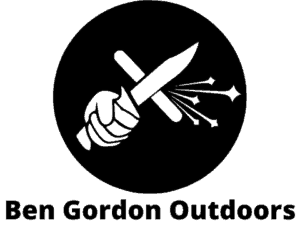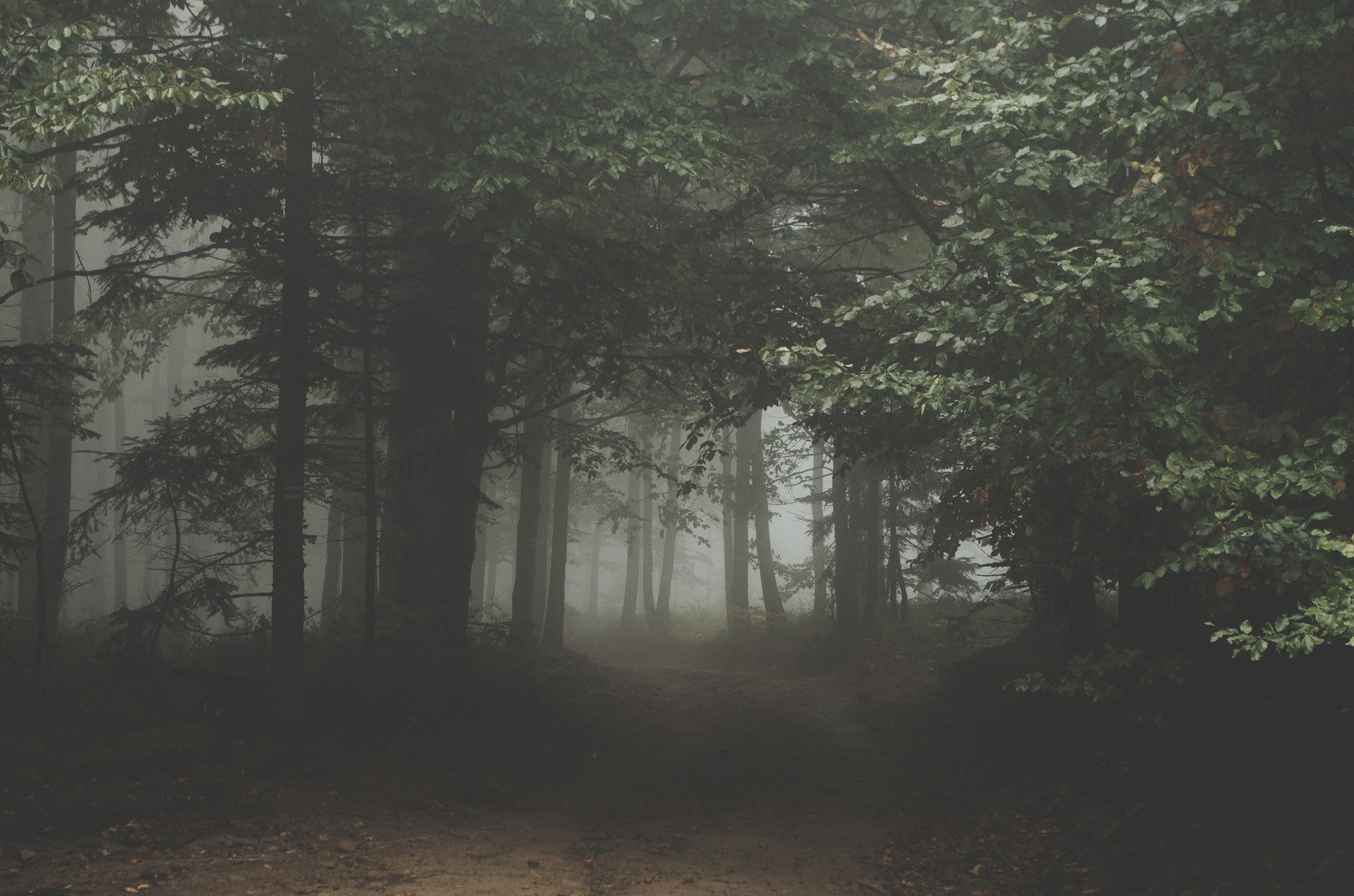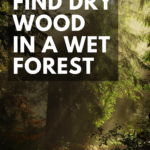It’s all well and good to be able to start fires in a designated campsite, with split and beautifully-seasoned oak, crumpled up newspaper, and an ample supply of lighter fluid to help things along.
It’s another thing entirely to start a fire in a woodland that’s been soaked with a week of rain.
The best way to find dry wood in wet conditions is to look for water-resistant tree species, and look for wood up off the ground, either hung-up, still attached to trees, or dead standing. Failing that, you can try splitting down large dead logs to expose their dry inner wood.
My time as a camp counselor had me leading trips of kids ranging from age 7 to age 17 on short hikes just down the trail from our main facility, as well as on week-long backcountry backpacking trips. When the weather was nice, we enjoyed sitting around the fire telling stories, singing songs, and playing games.
But when the weather turned nasty, and all we had was the packs on our backs, fire became a lot more essential. We didn’t just need it to warm up hot dogs, we needed that fire to bring our core temperatures back up after a full day’s hike in the soaking rain.
The biggest challenge was always finding dry fuel.
Once you have dry fuel and a dry place to sit, like under a tarp strung between trees, starting a fire in the rain is no different, and no more difficult, than starting it on a warm, sunny afternoon.
Even in wet climates, with weeks-long soaking rains, there’s almost always dry fuel to be found.
The challenge is knowing where to look.
Table of Contents
Pick the Right Tree Species
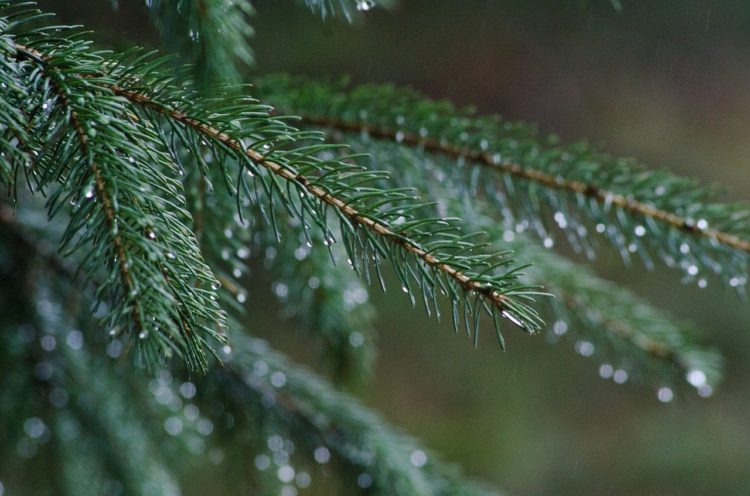
Natural forests are not composed solely of one tree species. They vary in composition with age, topography, water levels, soil types, and proximity to clearings. Some of these trees provide better fire resources than others, so those resources will be similarly distributed throughout the woodland.
Given the option, it helps to start your search for firewood in parts of the forest which give you the best chance of success. You need areas with lots of cover, some dead trees still standing or propped up off the ground, and the right species of trees.
My knowledge of trees is largely limited to the Great Lakes Region of the US and Canada, so you’ll need to adjust individual tree species for your area. Fortunately, many of the broader families of these trees occur the world over.
Poplar becomes water-logged and rots away very quickly. Oak is great firewood for the hearth at home, but it can take over a year to season down to dry.
Tree species vary in oil and resin content. Stickier trees, like pines and spruces, have wood that’s more water-resistant than drier, chalkier woods, like poplar/aspen.
The pitch concentrations in the wood have the added benefit of being very flammable.
Keep in mind that the resin content is not uniform within the wood of these species. As detailed at length in my article “Why do we Split Firewood”, the heartwood at the center of trees tends to be higher in resin content. Shoulders of pine and spruce trees, where large limbs and branches join the trunk, often host pockets of extremely resinous fatwood, wood saturated with resin.
Fatwood is a great fire starter. You can light chunks of it up with a direct flame, or scrape it with your knife to create a fine powder capable of converting sparks to flames quickly.
Once lit, fatwood burns like a candle. Small splits of it can burn for several minutes, giving you plenty of time and energy to cascade up your fire dominoes to larger fuel sizes.
Birch trees aren’t really resinous or pitchy, but their bark has very high concentrations of flammable, water-repellent oils. These oils enable birch bark to easily take a flame, even when pulled straight out of a puddle. This bark can be powdered to take a spark as well.
Make sure you grab from birch trees that are recently dead and up off the ground. Their soft, straight-grained and springy wood is wonderful for carving, but once water makes it past the barrier of the bark, it will rot birch away in a hurry.
Hung-up Sticks, Dead Still Attached
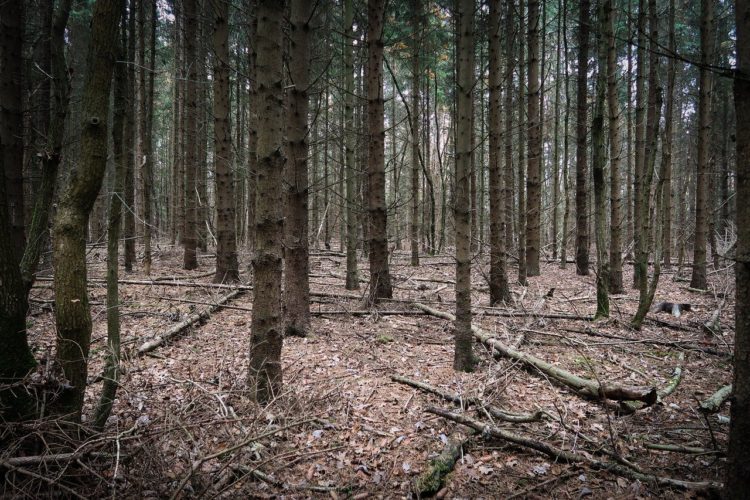
The ground is wet, and so is live. Dry wood is up, off the ground, and one of the most-overlooked options for dry kindling to get your fire going is hang-ups.
Hang-ups are branches that have died, fallen from their home, but never made it to the ground. They’ve become entangled in other branches of trees or brush below, and thus been kept off the ground. Branches drying up off the ground still get rained on, but the water drips off fairly quickly, without much opportunity to soak deep into the inner reaches of the wood.
Even in popular camping areas where most of the small kindling has been used off the forest floor, hang-ups can be a great source of dry fuel to get your fire going. Just make sure you’re in an area where collecting wood from the forest is allowed (it’s not allowed in some parks, for example).
Check out dense stands of evergreens as well. As the crown fills in above, lower branches of evergreens are shielded from the light, and the tree just lets them die off in order to preserve water. Those dead branches often remain attached to the trunk for a long time, making excellent kindling for the passing camper.
Try to snap a branch: if it’s brittle and breaks easily, it’s dry and great for your fire. If not, it’s still wet, and you don’t want it anyway.
The dense canopy that blocks out light also helps to shelter piles of dead sticks from the elements. If there’s a prevailing wind direction, head to the downwind (leeward) side of the trunks, and scoop up some dry twigs from that side.
Dead Standing Wood
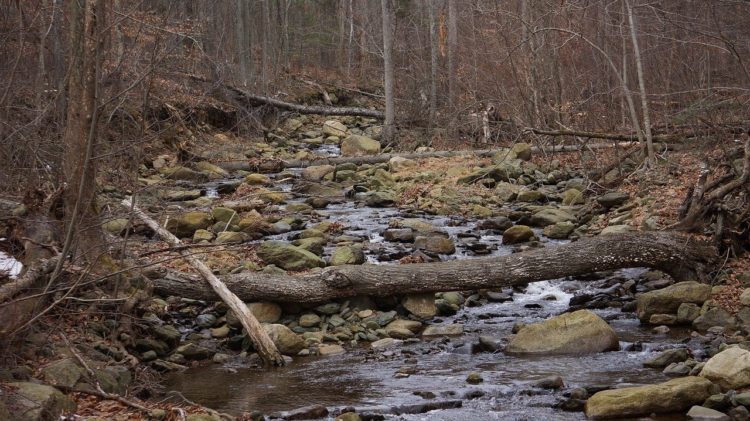
Just like with hang-ups and dead lower branches, whole trees can die off but remain off the ground. A tree that dies and remains standing will take a very, very long time to rot, providing you with plenty of opportunity to re-purpose it as firewood.
Snapped-off trunks will get wet on their upper and lower ends. It’s worth checking out the rest of the log though, as they may still be sound.
Pick up a solid stick and rap on the log near the end, feeling the sponginess and hearing the squelchy thud. Then move on to the mid-section, and rap on it again. If it’s still spongy and squelchy, move on to another option, but if it feels and sounds solid, continue exploring its length to determine if it’s worth your time and effort.
Split it Out
Surface moisture and core moisture are totally different things with firewood.
This is why a pile of seasoned oak doesn’t need another year to dry after it rains. Water takes a long time to migrate in and out of the fine, small cells that make up wood’s structure, so even submerging a piece of seasoned wood in water for a few days will not make it as wet (internally) as it was when it was alive.
When wood that had a chance to dry out is exposed to a lot of surface moisture, the outer bits do soak up water. But the core is still dry.
This means dead wood that was dry a little while ago will still have dry wood on the inside. To get at it, you’ll need an axe, hatchet, or knife.
It’s as simple as splitting or carving away the outer, wet layers of wood. This will expose the dry core of your wood piece, allowing you to start a fire.
Even with wood that’s starting to rot, there can be good dry, solid wood at the core. I’ve split good kindling out of spongy, moss-encrusted logs left to sit for years on a few occasions. It’s always impressive how dry that core can be, while the outer reaches will never take a flame.
Dry Tinder with Body Heat
Plan ahead. If you’re out backpacking in the rain, try to scoop up some dead grasses, birch bark, or other tinder materials while you’re still on the trail. The drier the better, but it can still be pretty damp to start.
Hiking generates a lot of body heat, especially in rain gear with limited ventilation. Make use of that heat by tucking a ball of damp tinder inside your rain jacket.
Try to keep that ball of tinder separated from direct contact with your body, or you’ll be sweating into the bundle, as well as feeling the cold damp mass against your body all day.
Starting the Fire
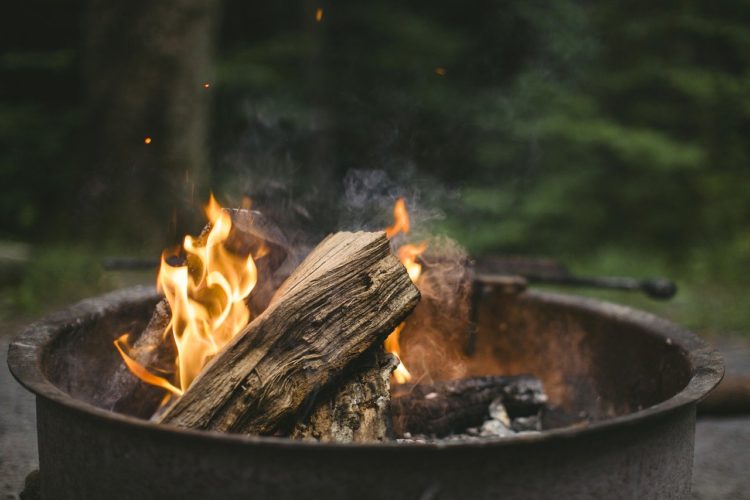
Fire with wetter wood just takes a little more time.
Make sure you have a firm grasp on the basics, because fire in wet weather does take a little more effort. I have instructions for the most sure-fire “one match fire” in the Fire section of my Beginning Camping article, and lots of tips on starting fire without matches in my Primitive Fire Skills article.
Water in the wood has to be boiled to steam and driven off before the wood can climb above the boiling point of water. More water present means we need more energy input to boil off that water, so it’s all about planning.
Don’t allow any heat to go to waste, spend any extra drying wood to grow your fire.
We also need to keep water from the ground out of our young fire. The ground is wet, so we need to isolate the tinder from the ground.
Build a Stage to Keep Moisture Out
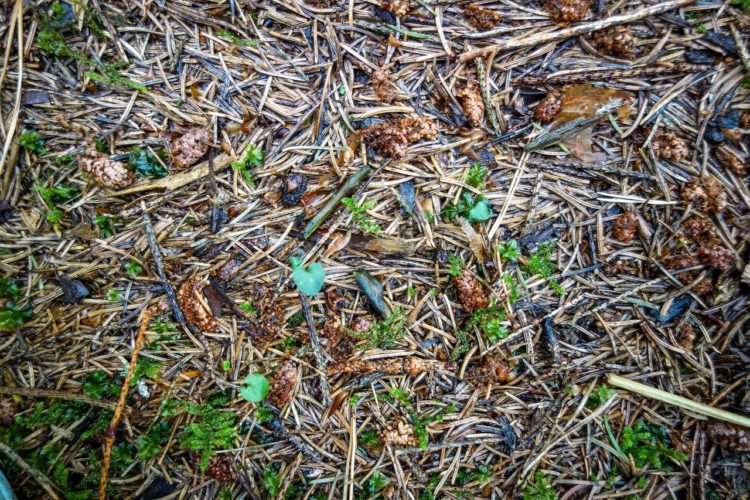
The ground is wet, even when you can’t see it. That moisture is why wood rots faster when in contact with the ground, and why dead pine needles off the ground won’t work very well for fire starters.
I always recommend building a “stage”, a layer of wood between the ground and your tinder, because it helps isolate the young flame from the wet ground, and allows more air in.
If you’re in a wet forest, or starting a fire at a campsite where people frequently douse their fires before bed, that stage becomes a must. Otherwise, the fire will boil moisture in the ground into steam, which will rise and put the young fire out.
The ideal stage is made up of dry logs about 4″ in diameter, quartered. Lay the bark side down, giving good deep channels for air to stream in. Depending on the wind, lay those channels to either protect the young flame, or funnel in more air.
More Kindling to Start
It takes more heat energy to drive off the moisture from wetter wood. Make sure you use three or four times as much kindling as usual, and two or three times as much tinder.
This isn’t as huge an imposition as it sounds.
Finding dry twigs and small branches is a lot easier than finding large dry logs, so you’ll come across plenty of kindling while hunting bigger fuel. If that’s not the case, just split down some of the larger fuel to form more kindling.
Eagle’s Nest Fire Lay to Dry More Wood
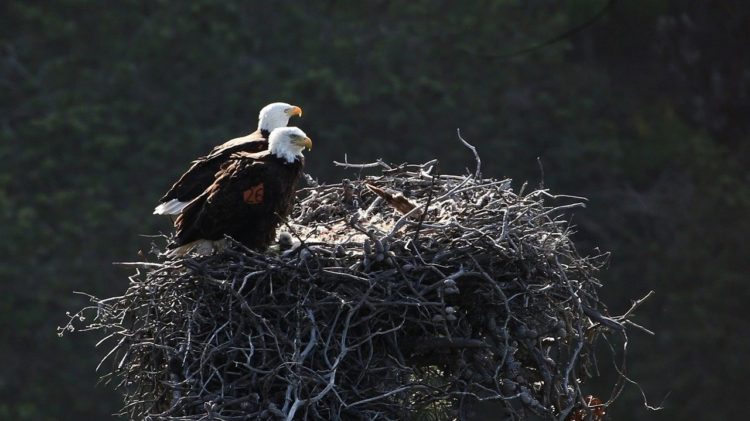
Eagles build nests just like a robin, but with large branches instead of grasses and twigs. They’re huge, impressive affairs, often handed down generation to generation. In my area, bald eagles can end up with nests 20′ across.
We’re going for a fire lay that emulates that huge ring of sticks. The heat going out radially from the fire is wasted if it’s not heating you or some wood, so put it to work.
Stack sticks in a jumble, about a foot outside the fire ring, leaving gaps anywhere people are sitting. The heat that would have gone to waste will instead preheat those sticks, driving moisture out away from the fire. This is much less taxing to a small fire than plunking huge wet sticks in directly.
Watch for steam off those sticks. If you’re not seeing any, they’re not close enough. Just be careful, as pushing them too close could result in a fire outside your ring. There’s a pretty good temperature gap between the boiling point of water and when sticks will start to burn, so it should be okay, but do keep an eye on it.
Tools
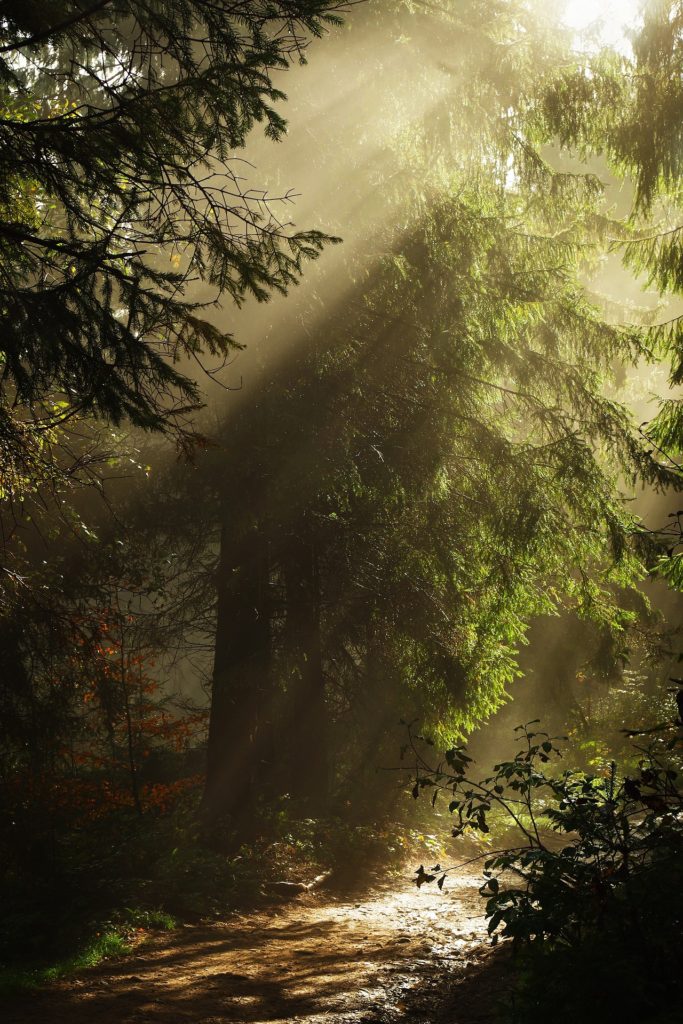
Having a few tools along can really help with processing down wet wood to get at the dryer core.
I carry a small folding saw, like the Silky GomBoy to cut logs to length on the trail. It’s also my go-to for lopping off trees that present a genuine navigational hazard on small rivers and streams.
A good hatchet like the Hults Bruk Almike, or a small axe like the Gransfors Bruks Small Forest Axe can be used to cut logs to length almost as well as the saw, with the added benefit of being great at splitting those logs to expose the dry core.
And a good heavy-bladed knife with a strong handle can be used to baton your way into the core of wet logs. The Morakniv Companion Heavy Duty is my knife of choice for this. It’s cheap enough that I won’t feel bad if I do break it, which is always a risk when you abuse a tool by doing something like batoning. I’ve never broken my Mora, but wouldn’t try it in a situation where my life depended on the knife.
As with any backcountry or survival skill, make sure you get out and practice before your life or welfare depend on it. Try building some fires from wet wood close to home, and build up your skills over time.
